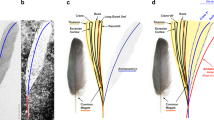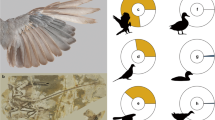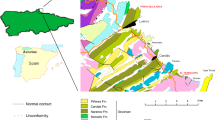Abstract
Arising from Xing Xu, Xiaoting Zheng & Hailu You Nature 464, 1338–1341 (2010)10.1038/nature08965; Xu et al. reply
Xu et al.1 describe the extraordinarily preserved feathers from two subadults of the oviraptorisaur Similicaudipteryx from the Yixian Formation of Liaoning, China. The preserved tail feathers of the juvenile specimen (STM4.1) show a morphology not previously observed in any fossil feathers. The tail feathers of an older, immature specimen (STM22-6) show a typical closed pennaceous structure with a prominent, planar vane. I propose that the feathers of the tail of the juvenile specimen are not a specialized feather generation, but fossilized ‘pin feathers’ or developing feather germs.
Similar content being viewed by others
Main
Xu et al.1 interpret the juvenile Similicaudipteryx tail feathers as examples of “proximately ribbon-like pennaceous feathers” (PRPFs) that have evolved convergently in avialian confuciusornithids and enanthiornithines, and in the non-avian maniraptoran Epidexipteryx. They describe the differences between juvenile and immature Similicaudipteryx feathers as a notable example of post-nestling ontogenetic change in feather morphology, and claim that “this phenomenon is not known to occur in other birds.”
Although modern birds do not show radical changes in flight-feather morphology after the nestling stage (probably owing to the functional constraints of flight), there are many examples of radical post-nestling changes in the morphology of other feathers. For example, the feather follicles on the head of a Wild Turkey (Meleagris gallopavo) grow plumulaceous down in nestlings, fully pennaceous contour feathers in juveniles, and specialized bristles in adults2.
Data from Xu et al.1 document that the tail feathers of the juvenile Similicaudipteryx specimen are very different in morphology from previously described PRPFs, in which the ribbon-like basal portion is formed completely by the lateral expansion and vertical compression of the rachis (Supplementary Fig. 3 in Xu et al.1). In contrast, the unbranched, proximal portion of the tail feathers of the juvenile Similicaudipteryx is not a merely a continuous, basal extension of the rachis (Supplementary Fig. 2a in Xu et al.1). Rather, the undifferentiated basal portion of these feathers surrounds the entire base of the exposed distal vane of the feather. The distal rachis does not expand laterally, and is visibly distinct from the broad base of the feather (top of Supplementary Fig. 2ain Xu et al.1). This observation is inconsistent with the conclusion of Xu et al.1
The juvenile tail feathers of Similicaudipteryx (STM4.1) are entirely consistent with the morphology of moulting feathers of living birds2. The tubular feather germ, called a pin feather, is surrounded by a keratinized sheath that falls off to expose the mature feather. Typically, the sheath begins to fall off the mature distal tip of the feather before the development of the ensheathed tubular base of the feather is complete. For a pennaceous feather, this intermediate stage of growth appears as a limited distal vane emerging from a smooth tubular base2 (Fig. 1). These feathers are not too large to be ensheathed because feathers need to grow to their final size and may shed the sheath at different lengths. Indeed, the moulting Great Horned Owl feathers in Fig. 1 are over 6-cm long, and are mostly ensheathed. These structures are also not too wide to be ensheathed feathers; the width of pin feathers depends on the number of barbs, the size of barb ridges and the angle of barb-ridge expansion after emergence3. These parameters all vary among living birds. Tiny natal down feathers sometimes adhere to the distal tip of molting feathers in living birds, but this is rare after the nestling stage and would be unexpected in juvenile Similicaudipteryx.
The distal tip of the planar vane of the pennaceous feathers are emerging from the tubular feather sheath. The sheath surrounds the entire base of the emergent vane, and the rachis runs under the sheath without lateral expansion. Photograph reproduced with permission from B. Hilton.
I propose that the tail feathers of the juvenile Similicaudipteryx are similar, or identical, in morphology to those of the immature Similicaudipteryx, but in the juvenile specimen they were preserved at an intermediate stage of development during emergence from the distal portion of the vane from the feather sheath. Little is known about the evolutionary origin of feather moult, and the discovery of fossil moulting feathers is an extraordinary achievement in dinosaur palaeontology. The title of Xu et al.1—“Exceptional dinosaur fossils show ontogenetic development of early feathers”—is still entirely consistent with this interpretation, but “ontogenetic” would refer to the growth of individual feathers rather than change over life.
The apparent simultaneous moult of tail feathers in Similicaudipteryx is similar to the first set of flight feathers in juvenile modern birds, but differs from adult modern birds in which tail feathers moult sequentially. However, sequential moult of remiges and rectrices is proposed to have evolved as an adaptation for flight to maintain aerodynamic function. Early feathered theropods would be unlikely to have evolved sequential moult. Simultaneous rectrix molt in terrestrial theropods may have preceded the evolution of sequential rectrix moult in modern birds.
References
Xu, X., Zheng, X. & You, H. Exceptional dinosaur fossils show ontogenetic development of early feathers. Nature 464, 1338–1341 (2010)
Lucas, A. M. & Stettenheim, P. R. Avian Anatomy: Integument (US Dept of Agriculture, 1972)
Prum, R. O. & Williamson, S. Theory of the growth and evolution of feather shape. J. Exp. Zool. 291, 30–57 (2001)
Author information
Authors and Affiliations
Ethics declarations
Competing interests
Competing financial interests: declared none.
PowerPoint slides
Rights and permissions
About this article
Cite this article
Prum, R. Moulting tail feathers in a juvenile oviraptorisaur. Nature 468, E1 (2010). https://doi.org/10.1038/nature09480
Received:
Accepted:
Published:
Issue Date:
DOI: https://doi.org/10.1038/nature09480
This article is cited by
-
Rarity of molt evidence in early pennaraptoran dinosaurs suggests annual molt evolved later among Neornithes
Communications Biology (2023)
-
A Mesozoic bird from Gondwana preserving feathers
Nature Communications (2015)
-
On the identification of feather structures in stem-line representatives of birds: evidence from fossils and actuopalaeontology
Paläontologische Zeitschrift (2012)
-
Xu et al. reply
Nature (2010)
Comments
By submitting a comment you agree to abide by our Terms and Community Guidelines. If you find something abusive or that does not comply with our terms or guidelines please flag it as inappropriate.




